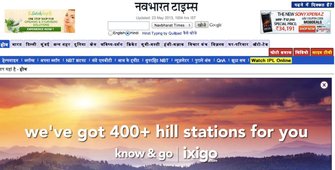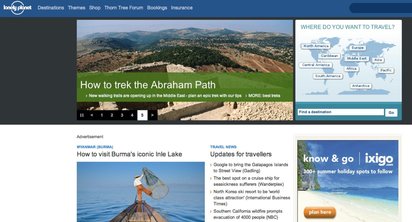Measuring up: marketing objectives that deliver value in modern times
For a travel planning service to become the first port of call in the customer journey requires constant ingenuity on the part of marketers. EyeforTravel.com finds out how one Indian trip planning service and search engine is putting its marketing strategy to the test.
When it comes to researching and booking travel, consumers are spoilt for choice. They are also not particularly trusting and will, as EyeforTravel’s recent research shows, visit up to 38 sites before booking a trip.
Travel brands must be nimble but their tactics must also depend on the target market, and also how new they are to the category. Brands can’t be too ambitious or inventive in the early days and shouldn’t miss any opportunity to reach out to a new set of customers.
Take ixigo, a trip planning service and search engine. It launched in 2007 and initially the team relied heavily on social and content marketing online and created the buzz among a specific set of people. Today ixigo’s customers arrive at the site via word of mouth and social media marketing (Facebook, Twitter etc.) rather than from more traditional marketing channels. However, ixigo also recognises that it must expand the awareness funnel and to include mass media options in the marketing mix.
EyeforTravel’s Ritesh Gupta talks to Saurabh Srivastava, VP marketing and product strategy at ixigo about how they are going about prioritising marketing initiatives.
EFT: How do you go about optimising the marketing mix accordingly?
SS: For ixigo initially the task was to reach out to a cross section of early adopters of technology and people interested in travel. We garnered feedback on the beta product and shaped this together before we were ready to go to the mass market. So fragmentation at this stage was easily avoided by using very specific channels of outreach like our own friends and people known to us, active users on social media and our website and the offline influencer community (people who huddle at travel cafes, active social travel bloggers and so on).
EFT: So how did you deal with the issue of fragmentation?
SS: Once this was done and we were ready to broaden the reach funnel we did two things to combat fragmentation and clutter:
1. We launched our first reach campaign online in April this year using all touch points like search, display and video. Since the objective was to position ourselves as a travel buddy (travel planning and search engine) and differentiate ourselves from OTAs in the market we developed a series of ads which were very fresh and unique from a communication delivery perspective and also clearly positioned us as a `know & go’ and hence information engine.
2. The sites and search queries that we optimised on were specifically planning oriented and not deals or packages that most of the OTAs in the market would harp on about. This meant that we reached a focused and relevant set of users who were looking for information on travel and not merely deal hunters. This again avoided fragmentation and helped us reach our targeted audience in an economical way.

We have actually seen a sharp rise in our direct and repeat visits as well as engagement time on the site.
EFT: In your view, what is central to working on diverse media mix?
SS: There are several factors that one needs to consider while choosing an ideal media mix. Again a lot of decisions by brands to adopt a medium or vehicle for reaching out to its audience is dependent on factors such as the brand’s current state, competition, consumer behaviour and intent of the campaign. Considering these factors and the fact that the media scene in India is evolving rapidly I think mass to niche options shall always co-exist. It is what fits best and should be worked on.
A great mix could be online tactical activity through SEM and remarketing, while for a more thematic and awe-inspiring campaign, it may be that the lead medium has to have an audio-visual component like TV or cinema in order to position the brand in a certain way.
Also, in the context of media mix, a brand also needs to answer the critical question of ratios between ‘paid’, ‘owned’ and ‘earned’ media which is more critical than the traditional media mix of mass versus niche.
New age brands need to create owned media and content across social media, interest-based blogs and branded entertainment which will generate high levels of consumer engagement and feedback, and be rewarded for the ideas and work. This if done will also lead to capturing earned media which has much higher credibility and shelf life than any form of marketing.

EFT: How do you approach your marketing initiatives?
For ixigo, marketing initiatives are, in all earnestness, engagement initiatives.
Our core product offering is centred on providing the most relevant information around travel to interested online users. So with the core objective of reaching out to more current and potential travellers we devise all our marketing plans.
The central idea or theme is to bring more people into our fold and constantly help them by answering their travel queries to help them create better travel plans. The proof of the pudding is in measuring the number of travel queries a user typed in our powerful semantic search bar to get relevant answers, the number of pages a user visited and the time spent in one session.
Our core product is online/mobile; online is the primary medium that we utilise for our outreach programmes whether it is contests or engaging posts on social handles, content marketing, mailers or thematic advertising.
Since we are not an e-commerce platform, all such marketing programmes have a success metrics based on relevant traffic growth and are clearly measurable.
EFT: How do you go about informing consumers about your product updates?
For us, the biggest and the most effective medium to reach out to its users is the website itself.
In the past, we effectively used inventory on our homepage to update our customers of new offerings and newly launched product features. There are various formats that we try to effectively communicate with, such as video and text banners or contextual search based ads and so on.
For example, when we launched our Indian rail and trains app on Android, we carried a banner across all landing pages of train search queries informing users of our latest app and how it helps. We did a similar thing for our in-Goa app (a mobile application that uses user current location and time to dynamically suggest relevant activities and places in the area). All users who searched or had Goa in the search string were told about this app on the landing pages.
Secondly, social media has proved to be an extremely effective medium to reach out to users and potential users. With a robust fan base of 400,000+ on Facebook and sizeable traffic on Twitter and Pinterest we leverage these handles to keep users abreast of new features and changes.
We also use an electronic document management system to reach out to users that have opted in and this has proved to be a great medium for information dissemination.
Finally, press releases on selective ‘big news’ have always given us a lot of visibility and traction and have been an effective marketing tool for us.

